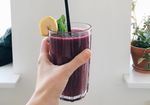Learn how to recognize hunger cues — plus, healthy snack ideas for between-meal noshes.
Whether you’re reaching for a sweet treat, a salty crunch or a protein pick-me-up between meals, snacking happens. And with so many tasty options lining grocery store shelves, those tempting bites often find their way into our carts, kitchens and stomachs. While easy access to food is not to be taken for granted, it makes learning how to snack in ways that fuel productivity that much more important.
To feel your best (and avoid any cookie-fueled naps on your keyboard), follow this advice.
Why We Snack
There are a lot of reasons we munch between meals; the first one being the most obvious: hunger. Sometimes we just need some sustenance to silence a rumbling stomach.
Another primary reason for snacking is the need for an energy boost. “Food is fuel, and oftentimes we feel sluggish and tired when we’re actually just hungry,” says dietitian Amy Shapiro, RD, founder of Real Nutrition. “The late afternoon — 3 to 4 pm — is often when blood sugar starts to dip and your energy declines, which is why I generally prescribe an afternoon snack for my clients.”
Occasionally, a craving stems from a deficiency in your diet or even a health issue.
Cravings can also drive you to snack — but it's not always because you know something delicious is waiting for you behind a cabinet door. Occasionally, a craving stems from a deficiency in your diet or even a health issue. It’s a cue for you to dig a little deeper and find out what your body is trying to tell you.
“For example, a common culprit of insatiable chocolate cravings can be a need for magnesium, or strong salt cravings can be a sign of missing trace minerals or even some adrenal exhaustion,” says Health Coach Katrine van Wyk. “I always ask people to pay attention to their cravings and investigate where they may be coming from so that we can address the actual root of it.”
In addition to physical instigators, there are psychological reasons we reach for the chips and guac. “Boredom, stress or a need for distraction from something uncomfortable or triggering — as in, as an escape from our feelings — is such a human and normal reason why we snack,” say van Wyk.
RELATED: What to Eat When You Have Anxiety
Learn Your Hunger Cues
Considering the myriad physical and mental commands your body gives you to snack, how can you determine when you’re actually hungry? One easy way: Drink a tall glass of water. “It's very common to confuse hunger with thirst. Oftentimes, when we are dehydrated we feel similar symptoms to when we're hungry — low energy, a headache and sleepiness,” explains Shapiro. So for starters, make sure you're drinking adequate amounts of water. A good rule of thumb is half your body weight in ounces daily.
When trying to decipher between your body needing fuel or wanting some chocolate-coated comfort, pay attention to what you grab. Van Wyk suggests asking yourself if you’re hungry for something nourishing — like an apple or carrots and hummus — or a bag of candy. Then, “if you're truly wanting real, whole foods, then eat them,” she says. “If the desire is a specific treat or just a need for oral stimulation, try taking a walk, journaling your feelings or drinking a cup of herbal tea before just giving in."
Another thing to consider: Are you just craving the proverbial "forbidden fruit"? If, for example, you’re on an elimination diet or a cleanse, you might be more likely to reach for a snack than when you’re not following specific guidelines.
“For some people, knowing a food is off limits can cause them to think even more about that food, leading to more cravings,” says van Wyk. “It's also common for people who are following a protocol to limit the amount of food they eat — which is not always what we want — and wind up feeling hungry and need to snack for that reason. For instance, reducing the intake of healthy fat can lead to more sugar cravings.”
How to Build a Healthy Snack
There’s a foolproof formula you can use to build a healthy and satisfying snack. “The best snack will contain at least two of these three nutrients: protein, healthy fat and fiber. This formula help you feel fuller for longer so you don’t get hungry 20 minutes after eating a snack,” says Amy Gorin, MS, RDN, a plant-based registered dietitian and owner of Plant-Based Eats in Stamford, Connecticut. “Examples of protein include nuts, seeds, Greek yogurt, eggs and smoked salmon. Healthy fats include avocado, olives, nuts, nut butter and seeds. And fiber-rich foods include whole-grain crackers, oatmeal, fruits and vegetables.”
Looking for easy, healthy snacks? Below, expert picks for inspiration:
Healthy Snacks Ideas
1. Protein Balls
Gorin loves prepping snacks to enjoy throughout the week. “I love making my own protein balls or energy bars for easy grab-and-go snacks,” she says.
RELATED: Matcha Bliss Balls That Support Your Energy and Immunity
2. Greek Yogurt and Berries
Another one of Gorin’s go-to snacks is Greek yogurt. “I’ll top it with some muesli or berries,” she says. Both options will give you enough filling protein, fat and fiber.
3. Chia Pudding
Van Wyk opts for snacks that are higher in fat and protein to keep blood sugar stable. Chia seed pudding — which is made with chia seeds, a plant-based milk and a topping such as berries — typically contains around 10 grams of protein.
4. Apple and Nut Butter
Another high-protein and high-fat recipe van Wyk loves is an apple with nut butter. Almond butter, for instance, gives you 3.4 grams of protein per tablespoon. Shapiro seconds this choice, but adds some spicy cinnamon for even more flavor.
5. Smoothie
If you want something that will instantly energize you, go for a smoothie. It’s one of van Wyk’s favorite snacks, and there are so many different ways you can make it. Pro tip: Pack it with plenty of veggies (like kale and spinach) for optimal nutrition.
RELATED: Coconut Strawberry Smoothie
6. Seed Crackers and Avocado
This is basically avocado toast in snack form, says van Wyk. It's a crunchy and creamy treat that will satisfy.
7. Hard-Boiled Eggs With Cut-Up Veggies
For a protein boost, Shapiro is a fan of eating hard-boiled eggs. If you pair them with cut-up veggies — like carrots, celery, broccoli or anything else you have on hand — you’ll wind up with an extra-filling snack.
8. Air-Popped Popcorn
You can’t go wrong with eating popcorn as a snack. Air-pop it and add a sprinkle of salt. “Popcorn contains fiber, so eating it on its own should keep you satisfied,” says Shapiro.
9. Hummus and Veggies
Shapiro endorses this classic combo. The hummus contains protein (around 1.2 grams per tablespoon), while the veggies provide filling fiber.




